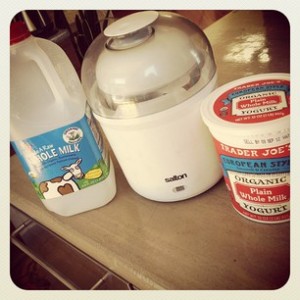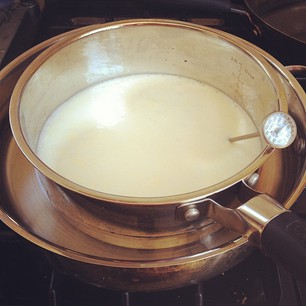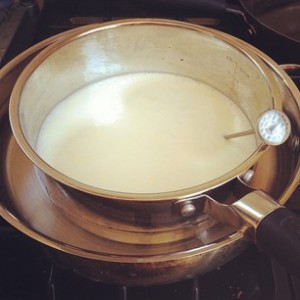Why balanced bacterial flora (probiotics) is vital for digestion (and immunity)
An unhealthy balance of gut bacteria is the cause of many digestive problems but it can also cause other serious health issues. We still don’t know much about all the different types of bacteria in our body, but it has been shown that when gut flora is out of balance (when bad bacteria outnumbers beneficial bacteria) serious autoimmune problems can occur.
The immune system lives in the gut and a healthy balance of good gut bacteria ensures healthy immune function and keeps everything running smoothly.
Probiotics are like tiny superheros that fight off the germy bad guys. After healing myself from IBS, my immune system went from wimpy to stellar! I never get sick and I think much of it has to do with my daily use of probiotic-rich foods like yogurt, kombucha, and fermented veggies like sauerkraut or kim chee. Healthy gut flora also supports the production of serotonin in the gut. So inadvertently getting more probiotic foods in your diet can make you happier!
Your body naturally contains probiotics, but there are things that can throw off the balance.
Taking antibiotics, the birth control pill, a build up of heavy metals, stress and a high carb/high sugar diet can encourage bad bacteria to overgrow and overtake the good guys.
It’s like you have rival gangs living in your body and when the numbers are equal, there’s peace. But when one gang grows and overpowers the other gang,it’s war and you’re the victim. But you can help support the good guys with probiotic food, drinks and supplements.
If you have to go on antibiotics make sure to decrease sugar and carbs and take a probiotic supplement after. Eating unsweetened yogurt with live, active cultures, miso soup or fermented veggies will help the good guys repopulate.
Green supplements like chlorella and fresh garlic cloves also help kill bad bacteria.
Make your own probiotic-rich yogurt
Yes, you can buy yogurt but making your own will create fresher, cheaper and higher quality yogurt. Also it is easy and fun.
Here’s an easy recipe.

This is what I need to make my own yogurt. You also need a food thermometer. I bought a Salton yogurt maker online for $20 but if you don’t want to buy any extra appliances it is easy to make your yogurt using two stock pots that fit inside each other. For directions using the stock pot and heating pad method go to this website.
I used organic raw milk for my yogurt because you can’t find unpasteurized yogurt in the store. I heated it up in a sauce pan until the milk reached 185 degrees ( it takes a few minutes). I monitored it with the food thermometer pictured below. Once it hit 185 degrees I took it off the stove and put it in a pan filled with cold water. You have to wait till it cools off to 110 degrees (it takes a few minutes) and then you can put about 2 to 3 teaspoons of commercial plain yogurt in there as a starter and mix it up!
That’s basically it. I pour the mixture into my yogurt maker and plug it in. All the yogurt maker does is heat the yogurt on very low heat for many hours. It is like a slow cooker for your yogurt! I leave my yogurt for about 7 to 8 hours but you can leave it longer if you want it to be more sour. The more sour it tastes the more good guys it contains.
Tip: If for some reason the yogurt comes out watery, just throw it in a blender with some bananas, other fruit or greens like spinach.
If you want more active probiotics in your yogurt simply leave it out of the fridge for an hour or two!




Kefir has been reported to be much more probiotic potent than yogurt and "kefir grains" which are the culture can be ordered online. Sorry I did not provide a convenient link, I will be more helpful in the future. Grateful to find this site today! Bravo!
Kefir has been reported to be much more probiotic potent than yogurt and "kefir grains" which are the culture can be ordered online. Sorry I did not provide a convenient link, I will be more helpful in the future. Grateful to find this site today! Bravo!
I second the kefir comment. It takes a little getting used to the taste, though, as it's kind of yeasty. That's Organic Pastures raw milk I see!
One question, though… aren't you basically pasteurizing the milk if you heat it to 185 degrees? HTST pasteurization, the most common method, requires heating milk to 161 degrees F for 15-20 seconds (according to Wikipedia). If you heat the milk to 185 degrees, you're already way past that level of pasteurization. Seems like it might defeat the extra cost (and benefits) of raw milk to pasteurize it.
Instead, you could try using mesophilic yogurt cultures, as opposed to thermophilic ones (commercial yogurt still works). I've actually done this with the exact same Organic Pastures raw milk you're using in that picture. I added some commercial yogurt to it, let it sit at ±85 degrees F for 12-24 hours (in the oven with the oven light on is perfect), and came out with some still-raw, tangy, drinkable yogurt that was quite delicious. (You don't get the firmness of commercial yogurt, because that uses thermophilic cultures, which require higher temperatures to multiply and set the milk into a firmer yogurt. I'm not sure if it's even possible to make really-thick yogurt that hasn't been pasteurized / heated.)
Hurts my heart to see raw milk being pasteurized!
–Devin from the BTC course.
Devin and Shoshana, thank you both for your comments! I absolutely adore Kefir. I am Russian and grew up drinking it! But it can be a little strong for people who are not used to it. But I agree with you Devin, it might be a waste to use raw milk for yogurt, however, it would be great for kefir which doesn't need to be heated at all, just drop in the grains and leave out on the counter for a day or so!
[…] a link to an article on making your own plain […]
So what milk do you use? We use Kefir in goats milk. Do you recommend using this though, as according to your site you say no dairy.